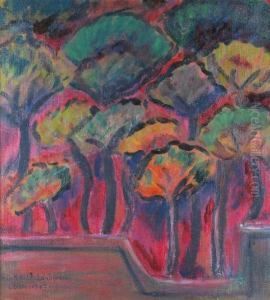Hanka Ordonowna Paintings
Hanka Ordonówna was a prominent Polish singer, actress, and dancer whose artistic career flourished during the interwar period. Born as Maria Anna Pietruszyńska on September 25, 1902, in Warsaw, she later adopted her stage name and became one of the most beloved figures in Polish entertainment.
Ordonówna's career began in the early 1920s when she started performing in cabarets and theatres in Warsaw. Her exceptional beauty and charismatic stage presence quickly garnered public attention, and she became a star of the Warsaw entertainment scene. She was particularly known for her performances at the famous 'Qui Pro Quo' cabaret. Her talent extended beyond singing as she also made a name for herself as an actress in operettas and plays.
During the 1930s, Ordonówna's fame reached new heights. She starred in several Polish films, becoming one of the era's leading actresses. Her roles in movies such as 'Pieczone gołąbki' (1933) and 'Szpieg w masce' (1933) contributed to her status as a popular film star. Alongside her film career, she continued to perform on stage and was known for her renditions of tango songs, which became extremely popular in Poland during that time.
Ordonówna's life took a dramatic turn with the outbreak of World War II. She was in Romania when the war began and was unable to return to Poland. During the war years, she was active in supporting Polish refugees and the Polish Armed Forces in the West. Her charitable work included organizing concerts for soldiers and fundraising for the Polish cause.
After the war, Ordonówna settled in Egypt with her husband, Count Michał Tyszkiewicz, whom she had married in 1931. Her health deteriorated in the post-war years, and she struggled with tuberculosis. Hanka Ordonówna passed away on September 8, 1950, in Beirut, Lebanon, after a prolonged illness.
Hanka Ordonówna is remembered as a symbol of the golden age of Polish culture in the interwar period. Her legacy as a performer and a patriot who used her talents to support her fellow countrymen during times of strife endures in Polish cultural memory. Her recordings and films continue to be appreciated, and she is often cited as an inspiration by contemporary Polish artists.
